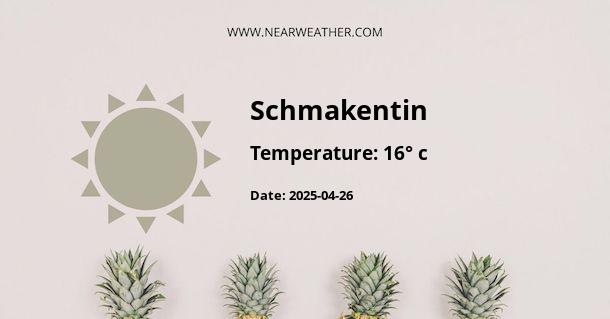Understanding the Climate and Weather Patterns in Schmakentin, Germany
Located in the northeastern part of Germany, Schmakentin is a region that experiences a temperate oceanic climate. The weather in Schmakentin is characterized by four distinct seasons, with variations in temperature and precipitation. In this comprehensive overview, we will delve into the different aspects of Schmakentin's climate, providing a month-by-month breakdown of weather conditions, along with statistical data to give a clearer understanding of what to expect weather-wise throughout the year.
Seasonal Climate Overview
Before diving into the monthly details, let's establish a broader picture of the climate in Schmakentin. As part of the broader German climate, the area bears the typical features of central European weather patterns:
- Spring (March to May): This season sees gradually increasing temperatures and longer daylight hours. Precipitation is moderate.
- Summer (June to August): Summers are generally warm but not excessively hot, with occasional heatwaves. Rainfall is relatively high during this period, often accompanied by thunderstorms.
- Autumn (September to November): This is a transitional period with temperatures dropping and precipitation still frequent. Days become shorter as the region heads into winter.
- Winter (December to February): Winters can be cold, with temperatures frequently dropping below freezing. Snowfall is possible, but not as heavy as in more mountainous regions of Germany.
Monthly Climate Details
For a more granular understanding of Schmakentin's weather, we'll explore each month separately:
January: The coldest month of the year, with average low temperatures of -1°C (30°F) and highs around 3°C (37°F). Snow and frost are common, and the daylight lasts for approximately 8 hours.
February: Similar to January, with cold temperatures and potential snowfall. Daylight starts to increase, signaling the coming change in season.
March: Marks the beginning of spring, with average temperatures ranging from 1°C (34°F) to 8°C (46°F). Precipitation starts to decrease, and the landscape begins its gradual greening.
April: A noticeable jump in temperatures occurs, with average lows of 4°C (39°F) and highs of 13°C (55°F). Precipitation is moderate and spring is in full swing.
May: Temperatures continue to rise, with averages from 8°C (46°F) to 19°C (66°F). May often has longer periods of sunshine and less precipitation, making it one of the more pleasant months.
June: This month kicks off the summer, with temperature averages between 11°C (52°F) and 21°C (70°F). Precipitation is slightly higher, with possible thunderstorms.
July: Typically the warmest month of the year, with average lows of 14°C (57°F) and highs around 23°C (73°F). Rainfall is common, with July also ranking as one of the wettest months.
August: Similar to July, with warm temperatures and a high likelihood of rainfall and thunderstorms. This is the last full month of the summer season.
September: The transition to autumn begins. Average temperatures decline to between 10°C (50°F) and 19°C (66°F). Rainfall remains high as the weather patterns start to shift.
October: A significant temperature drop takes place, with averages from 6°C (43°F) to 13°C (55°F). This month sees the onset of fall foliage, and precipitation begins to decrease.
November: Marks the advent of cooler days, with average temperatures ranging from 2°C (36°F) to 8°C (46°F). This month can be quite grey and rainy as winter approaches.
December: Officially beginning the winter season with short days and long nights, temperatures average between -1°C (30°F) and 3°C (37°F). Snowfall can vary from year to year.
Precipitation and Extreme Weather Events
Precipitation is fairly distributed throughout the year in Schmakentin, with a tendency to peak during the summer months due to convective thunderstorms. The region receives an average annual rainfall of around 600 mm (23.6 inches), with variability according to yearly weather patterns. While extreme weather events such as severe storms and flooding are less common, they can occur and are often associated with larger patterns influencing the entire European continent, such as the North Atlantic Oscillation or continental high-pressure systems.
Weather Trends and Climate Change Implications
Climate change is impacting weather patterns across the globe, and Schmakentin is no exception. Studies indicate shifts in the timing of seasons, with warmer temperatures extending the length of the growing season and potentially leading to more variable precipitation. This could result in both increased instances of drought and heavy precipitation events, altering the historical climate norms of the region.
Conclusion
Understanding Schmakentin's weather is crucial for multiple sectors, including agriculture, tourism, and local infrastructure planning. The unique combination of its temperate oceanic climate with the influences of larger atmospheric patterns makes for a diverse and sometimes unpredictable weather system. With the backdrop of climate change, it's important to continue monitoring these shifts for both local adaptation efforts and broader environmental impact assessments.
Professional Considerations
Industry professionals and researchers rely on detailed climate data to predict weather patterns, inform agricultural practices, and support climate resilience strategies. Accurate and localized weather forecasting models are essential tools for professionals working in sectors sensitive to climate variability.
In conclusion, Schmakentin's climate presents a dynamic and evolving challenge that requires thorough analysis and ongoing observation to ensure both the community's well-being and the success of businesses and services that are weather-dependent.
A - Schmakentin's Latitude is 53.883331 & Longitude is 11.566670.
A - Weather in Schmakentin is 16° today.
A - Climate Conditions in Schmakentin shows broken clouds today.
A - Humidity in Schmakentin is 47% today.
A - Wind speed in Schmakentin is 14.72 km/h, flowing at 78° wind direction. today.
